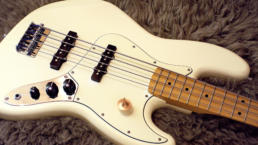5 Iconic Bass Guitars You Should Know
In life, sometimes the loftiest goals are achieved by those who establish strong foundations. For instance, if you dreamed of building the tallest skyscraper, it might be smart to focus on its structural engineering rather than what color the windows should be. In music, building a sturdy “foundation” for any song starts with the bass. And in any contemporary band setting, the best way to ensure a solid bass foundation is to pick the right bass guitar for the job.
In this blog, we’ll be covering 5 of the most iconic electric bass guitars to ever be conceived. Ever since the electric bass was invented in the 1930s, this handful of legendary low-end-senders have rocked more socks off than any others. Keep reading learn about 5 iconic bass guitars you should know!
1. Fender Precision Bass
Speaking of the invention of the electric bass, let’s explore where it all started! Leo Fender and George Fullerton are effectively the Henry Fords of the electric bass world. Although this instrument’s conception is credited to Paul Tutmarc for his 1935 “Model 736 Bass Fiddle,” Leo and George were the first to mass produce it. The Fender Precision Bass, also dubbed the “P-Bass,” came to market in 1951 and changed live music forever. It instantly solved many of the inconveniences that arose with its predecessor, the upright bass.
The name, “Precision” refers to a player’s ability to precisely finger notes with the help of frets. This allowed guitarists to transition to the rhythm section without needing to use proper intonation technique, which is required when playing an upright bass. The P-Bass’ split humbucker pickup, body, and other technical aspects have remained essentially unchanged since 1957. Some famous P-Bass players include James Jamerson (Motown Records), Sting (The Police), and Paul Simon.
You can find one of these legendary beauties on Sweetwater.com. Learn how to wield its true power with bass lessons right here on JamPlay!

2. Fender Jazz Bass
Making its first appearance in 1960, Leo Fender’s Jazz Bass offered some stylistic and technical differences from the P-Bass. Cosmetically, its offset design is said to have been inspired by the Fender Jazzmaster guitar. The J-Bass also offers a much thinner tapered neck toward the lower frets, and features two single-coil pickups designated for the neck and bridge, respectively. Because of its pickups and their arrangement, the Jazz Bass provides a tone that’s brighter than the P-Bass. So, this bass is often a favorite for using the slap bass technique.
In terms of historical and global influence, Fender’s J-Bass and P-Bass are the undisputed kings of the electric bass guitar world. No other bass guitars are as widely recognized, played, and emulated as these two. Some notable bassists who have signature models of the Fender Jazz Bass in particular include Mark Hoppus (Blink -182), Flea (The Red Hot Chili Peppers), Geddy Lee (Rush), and the acclaimed Jaco Pastorius.
You’ll have no problem finding a Fender Jazz Bass on Sweetwater.com. You can also improve your bass playing skills alongside educators playing this very type of bass on JamPlay!

3. Rickenbacker 4001 / 4003
Nothing says “warm & punchy” like a Rickenbacker bass guitar. The 4001 model pictured here is the updated version from the original 4000 model, with two single-coil pickups instead of one. This model was produced from 1961 to 1981. The 4001 was then replaced by the 4003 model, which featured higher output pickups, more durable fret wire, and a redesigned bridge pickup. One notable feature on both models is Rickenbacker’s trademarked “Rick-O-Sound” stereo output. This feature allows the player to route the signal from the neck and bridge pickups independently. A popular application of this is to send the bridge pickup (the brighter of the two) through an effects chain, while sending the neck pickup to a clean channel in order to preserve an un-distorted bass tone.
The 4001, and subsequently the 4003, were made most famous by Beatles bass player, Paul McCartney. A left-handed 4001S was Paul’s axe-of-choice from 1965 until the late 1970s. Two other notable players of the 4001 or 4003 include Chris Squire (Yes) and Lemmy (Motörhead).
Because they are discontinued, 4001 models are trickier to get ahold of. But, Rickenbacker still produces 4003 models to this day; you can order one on Sweetwater.com! Remember to also brush up your skills on this legendary axe using JamPlay’s bass courses.

4. Höfner Violin Bass
In 1887, Karl Höfner founded a stringed instrument company in his own name. And, within a few decades, the Höfner brand became globally-recognized for its quality. Though Karl would not live to see it, the Höfner company would eventually produce one of the most iconic bass guitars in history: the 500/1 model. This bass, which Höfner still produces today, features a hollow, violin shaped body, two signature humbucker pickups, a two-piece bridge system, and a distinctive set of tone and volume controls.
Technical features are not what launched this bass into the limelight, however. In the same fashion as the Rickenbacker 4001, the Höfner 500/1 achieved its iconic status because it was favorited by Beatles bassist and singer, Paul McCartney. Supposedly, Paul gravitated to the 500/1 because, at the time, it was significantly cheaper than a Fender bass. Some other notable users of this bass are Kevin Parker (Tame Impala) and Satomi Matsuzaki (Deerhoof).
A vintage 500/1 will likely run you upward of $5000. However, Höfner has issued several more affordable versions of this classic bass guitar. You can find them for under $500 on Reverb.com! Don’t forget to brush on your bass skills and check out some Beatles song lessons on JamPlay!

5. Music Man StingRay
The last iconic bass on this list brings us full circle; Music Man is a company founded in the 1970s by two former Fender employees, Tom Walker and Forrest White. Leo Fender himself was a silent partner of the Music Man until his non-compete agreement expired in 1975 and was voted president of the company.
Then in 1976, Leo Fender, Tom Walker, and Sterling Ball developed the first version of the StingRay bass. Cosmetically, the StingRay resembles a Fender Precision Bass. However, this novel instrument features some upgrades that make it desirable to a different type of player. Aside from their notoriously high-quality construction, SingRay basses generally come with humbucking pickups with the option of 2 or 3-band EQ preamps built in. This provides players with a huge amount of tone control! Thus, they are an obvious pick for bass players seeking a versatile instrument. StingRays are popularly used in rock and funk music, especially for players employing a slap bass technique.
Some notable players of the StingRay are Tony Levin (Peter Gabriel, King Crimson), Louis Johnson (Michael Jackson), and Flea (The Red Hot Chili Peppers).
You can find a true StingRay bass for just under $2500 on Sweetwater! If you’re looking for this style of bass guitar at a more affordable price, consider checking out a Ray bass by Sterling (a subsidiary of Music Man) on Reverb.com.
Excited to look at some new gear? Find all kinds of great guitar gear deals over at Sweetwater.com.
For bass guitar lessons that will put you way ahead of the game, check out JamPlay.com! JamPlay also has over 450 guitar courses from 120+ instructors, and online guitar lessons tailored to every skill level, music genre, and playing style. Click here to learn more.
Share this
Become a JamPlay member for unlimited access to 7000+ guitar lessons and 120+ artists and instructors. View membership plans ›




